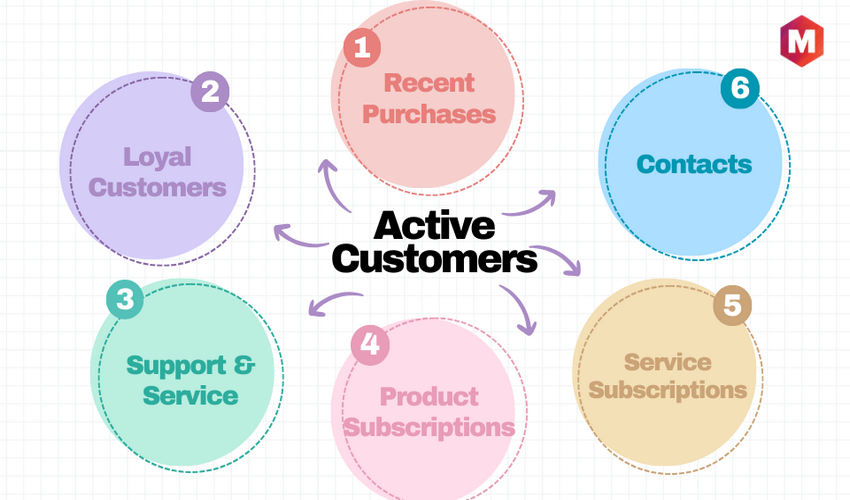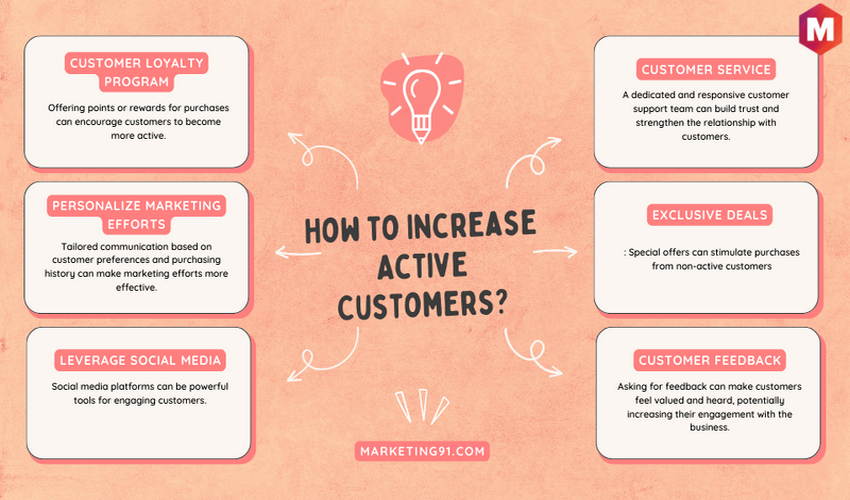Table of Contents
What are Active Customers?
Active customers refer to individuals who have interacted with a business’s products, services, or platforms within a specific timeframe. This interaction can be in the form of purchases, subscriptions, or consistent use of a platform or service. The timeframe for an active customer usually varies depending on the nature of the business.
For example, an active customer for a retail store would be someone who has made a purchase within the last 30 days, while an active customer for a streaming service could be someone who has opted for an annual subscription.
Key Takeaways!
- Active customers make at least one purchase from a business within a specific period, showing engagement and contributing to the company’s revenue.
- Companies track and monitor active customers’ behavior using payment data to optimize business strategies.
- Active customers provide valuable data through their product or service payments, which can enhance future sales strategies.
Types of Active Customers
1) Recent Purchases
Recent Purchasers are customers who have recently bought from your business. Their recent purchase indicates interest in your offerings, making them prime targets for nurturing and retention. They provide valuable insights into market trends and customer preferences.
2) Loyal Customers
Loyal customers are those who consistently choose your business over an extended period. They show their loyalty through repeat purchases or continuous use of your services. These customers are crucial as they contribute to revenue and can act as brand ambassadors, recommending your business to others.
3) Support & Service
Support and service include customers who frequently interact with your business through customer service channels. They may seek assistance with product inquiries, complaints, or other service-related issues. Their engagement provides valuable feedback to improve customer satisfaction and retention.
4) Product Subscriptions
Product Subscriptions refer to active customers who subscribe to your products on a recurring basis. Their ongoing commitment represents a reliable revenue stream and reflects their perceived value in your product. Monitoring these customers can provide insights into what products are performing well and where improvements can be made.
5) Service Subscriptions
Just like Product Subscriptions, Service Subscriptions involve customers with ongoing subscriptions to your services. This group includes subscribers to digital platforms, maintenance services, or other long-term service offerings. These customers provide steady revenue and valuable insights into the quality and relevance of your services.
6) Contacts
Contacts are active customers who interact through different communication channels like email, social media, phone calls, or in-person visits. They offer direct communication, enabling personalized service and fostering strong customer relationships.
Steps for Active Customer Experience Management
- Identifying Customer Lifecycle Stages: The first step in active customer experience management involves a clear understanding of the different stages in your customer lifecycle. This involves recognizing each phase in a customer’s journey, from their first interaction with your company to the completion of the buying process.
- Recognizing Customer-Facing Business Processes: In this step, it’s crucial to determine the business processes that directly impact your customer base. These are the procedures that your customers interact with directly, each time they deal with your business.
- Identifying Key Events in Customer-Facing Processes: Once you’ve identified the customer-facing processes, the next step is to recognize the key events that occur within these processes. These events provide valuable customer insights, allowing you to understand what works, what doesn’t, and where improvements can be made. This understanding enables your company to optimize processes, ensuring that every interaction is a positive one for your unique customers.
- Configuring and Managing Alerts: In order to maintain a steady influx of new customers and retain existing ones, it’s important to set up and manage alerts about key events. These alerts ensure that your team is aware of any issues or opportunities in real time, allowing swift action to enhance customer satisfaction and improve the customer lifecycle.
- Developing a Customer Action Plan: The final step involves creating a clear, actionable plan based on the insights gained from the previous steps. This plan should outline strategies for addressing the unique needs and expectations of your customers at each lifecycle stage. The goal is to turn every first purchase into an ongoing relationship, thereby increasing the total number of loyal, active customers.
Active vs. Non-active Customers
| Criteria | Active Customers | Non-Active Customers |
|---|---|---|
| Engagement | Active customers regularly engage with the business, either through frequent purchases, participation in loyalty programs, or consistent communication with the business. | Non-active customers show low engagement, either infrequently making purchases or not participating in loyalty programs. Communication with the business may be sporadic or non-existent. |
| Revenue Contribution | Active customers contribute a significant amount of revenue to the business. The frequency and consistency of their transactions make them valuable to the organization's bottom line. | Non-active customers contribute less to the business's revenue due to their infrequent transactions. They represent a group where potential growth can be explored. |
| Customer Lifetime Value (CLV) | The CLV of active customers is high, given their frequent transactions and engagement with the business. They are likely to bring in more revenue over their lifetime as a customer. | The CLV of non-active customers is lower, due to their limited engagement and transactions with the business. The business should work on strategies to convert these customers into active ones. |
| Relationship with the Business | Active customers generally have a strong relationship with the business, characterized by frequent interactions and a high level of trust. | Non-active customers may have a weaker relationship with the business, with limited interaction and possibly less trust. |
How to Increase Active Customers?
Strategies to increase active customers could include personalized marketing campaigns, introducing a loyalty program, or offering exclusive deals. Some of the ways to do this are:
- Implement a Customer Loyalty Program: Offering points or rewards for purchases can encourage customers to become more active. Exclusive benefits can create a sense of belonging and incentivize regular engagement.
- Enhance Customer Service: A dedicated and responsive customer support team can build trust and strengthen the relationship with customers. A positive customer service experience can boost customer engagement.
- Automate and Personalize Marketing Efforts: Tailored communication based on customer preferences and purchasing history can make marketing efforts more effective. Personalization can lead to higher engagement and conversion rates.
- Offer Exclusive Deals or Discounts: Special offers can stimulate purchases from non-active customers. Frequent discounts or exclusive deals can motivate customers to engage more with the business.
- Leverage Social Media: Social media platforms can be powerful tools for engaging customers. Regular updates, engaging content, and responsive communication on these platforms can attract and retain active customers.
- Request Customer Feedback: Asking for feedback can make customers feel valued and heard, potentially increasing their engagement with the business. Feedback can also provide valuable insights for improving products or services.
Conclusion!
In this post, I have discussed what active customers are and why engaging with them is important for businesses. By actively engaging with customers, businesses can not only retain existing customers but also attract new ones through positive word-of-mouth.
Active customers are more likely to make purchases, contribute positively to the image of the business, and provide valuable feedback for improvement.
FAQs
1) What is the meaning of active customers?
They are individuals who frequently interact with a business’s products or services, making regular purchases and actively engaging with the organization.
2) How can businesses engage with active customers?
Businesses can engage with these customers through tailored communication, offering exclusive deals or discounts, leveraging social media platforms, and requesting customer feedback.
3) Why is engaging with active customers important for businesses?
Engaging with them boosts loyalty and sales. They’re also more likely to spread positive word-of-mouth and provide valuable feedback for improvement.
Liked this post? Check out the complete series on Customer Management

